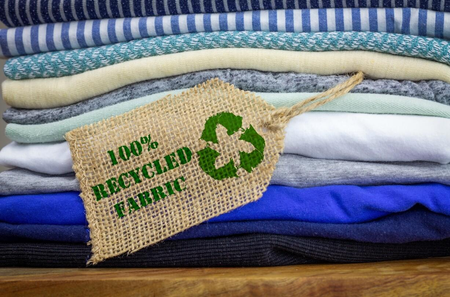The global fashion industry has contributed to climate change and its associated effects. With an overall change in the structure that is in line with sustainable development, the industry can make a visible change in mitigating climate change and its effects.
Global Climate Change
Global warming refers to the warming of the Earth over a larger period. Although warming has taken place for years, it has sped up greatly over the past few years. Since the industrial revolution and the use of fossil fuels, the globe has experienced exponential levels of rising temperatures. This pressure on the environment is bound to further increase with the rise in the global population. Global warming has in turn also paved way for climate change which leads to a greater global impact, across various fronts.
Projected Impacts of Global Climate Change

Fossil fuels are used excessively by the fashion industry. These contribute to greenhouse gas emissions especially carbon dioxide leading to global warming. The increased world temperatures have been hard-hitting and resulted in the melting of glaciers. The ice sheets in the Arctic and Antarctic have been observed to melt causing a rise in sea levels across the globe. The low-lying areas especially the islands and coastal areas are at risk of drowning.
Additional effects include a loss of biodiversity due to rising temperatures. Animals are forced to migrate to cooler areas and rehabilitate. Those unable to move are feared to become endangered and ultimately become extinct if temperatures continue to rise.
Weather Changes in US
Over the years, temperatures have changed in the US with many events of drastic temperature fluctuations. A rare extreme cold was observed in 2021 accompanied by freezing, blizzard, and temperatures falling unusually low in many areas. Texas, which lies to the south side and is considered to be hot, experienced continuous snowfall and record-breaking cold temperatures.
On the contrary, spells of extreme heat were also observed in the US. Temperatures soaring beyond 40°C were commonly observed and many forests succumbed to wildfires. Elevated temperatures resulted in some of the deadliest heatwaves ever observed.
Effects of Extreme Weather in US
Some of the major issues faced by the residents of the US during the extremely chilly weather include the massive disruption of water supplies. Large scale power outages left the inhabitants unable to operate the hydraulic system leaving them with serious domestic water shortages. The extremely low temperatures ruptured water pipes. In addition, severe snow accumulation resulted in a loss of movement, in turn affecting supplies and availability of materials.

Alternatively, extreme heat resulted in wildfires, for example, the massive fires in California that not only affected the residents in the vicinity but killed the animals living within. Elevated temperatures resulted in many sudden deaths from heatstroke and many ended up in hospitals with heat-related issues.
Causes of Climate Change and the Fashion Industry
The fashion industry is known to be greatly involved in climate change. According to Mckinsey's research, about 2.1 billion metric tons of greenhouse gas (GHG) emissions were related to the fashion industry, in 2018. This makes about 4% of the total global emissions. The Intergovernmental Panel on Climate Change (IPCC) set out a 1.5-degree climate change mark to help mitigate the effects. To achieve this mark, the fashion industry needs to reduce its GHG emissions to 1.1 billion metric tons of CO2 equivalent by 2030. However, with the current scenario, this seems highly unlikely.
According to UN Alliance for Sustainable Fashion, the fashion industry is responsible for about 10% of global carbon emissions and 20% wastewater. In a disturbing turn of events, the fashion industry is known to suck up more energy than both shipping and aviation combined. For example, an average cotton t-shirt would release up to 2kg of carbon dioxide equivalent while a polyester dress would release 17kg of carbon dioxide equivalent into the atmosphere.

How Sustainable Fashion can Reverse Climate Damage?
To make fashion sustainable, certain changes need to be carried out in the overall structure of the industry. By changing the fashion landscape, it is possible to reduce the impacts of climate change, if not fully reverse it. Some of the basic initiatives could include a transition to renewable energy with energy-efficient improvements operational improvements and a change of consumer behavior. These steps could be aided by the collaboration of brands and retailers, especially the ones that are major players in the fashion industry. In addition, public figures associated with the fashion industries such as models and influencers may also contribute to creating awareness amongst the consumers.
Sustainable Production and Consumption
By revamping the fashion industry to reduce carbon footprint, mitigation of climate change can be hoped for. However, much work needs to be done by various players. Beginning at the government level, the regulators should work to implement strategies outlined to help with the objective. Incentives that support decarbonization, emission transparency, sustainability-focused innovation along an awareness for conscious consumption are bound to change an overall perspective that is more acceptable and convenient for sustainable fashion. Enlisted below are the strategies at various steps and the estimated levels of improvement that can be achieved upon shifting to a more eco-friendly setup:
- Reducing Toxicity from Upstream Operations
This refers to the reduction of pollution in the form of elements present in the raw products and fibers made for further processing. About 61% of mitigation is estimated upon decarbonization of the materials used. Additionally, shifting from fossil fuels to renewable energy sources could reduce about 1 billion metric tons of emissions by 2030, from the fashion value chain.
- Reducing Emissions from Brand Activity
Brands can contribute by making sure the fiber material used is recycled and capable of being biodegraded; decarbonizing the various steps involved; wrapped in environment-friendly packages; transported through means that use renewable energy; and reducing excessive production. These steps alone are estimated to reduce 308 million metric tons of CO2 equivalents.
- Consumer Behavior Encouraged for Sustainable Options
Acceptance of preloved garments, resale, cutting down on excessive shopping, refurbishment, repair, increased recycling, and appropriate disposal are some of the ways consumers can be encouraged for sustainable choices. A reduction of about 347 metric million tons emission is estimated upon the restructuring of the fashion industry along eco-friendly lines.

Puremsx and Solutions to Climate Change
Puremsx is aimed to contribute to reducing damage to the climate and the environment. We at Puremsx understand that serving mankind begins by serving Mother Nature. Hence, we strive to contribute our part in making Earth a habitable place to live in.
The Philosophy Behind Puremsx

Puremsx believes in producing winter wear keeping animal welfare and eco-friendly fashion at the helm. Responsible production as well as recycling fabric are the principles that drive us. For our warm wear, we make polyester that is made by an eco circle recycling system. These polyester fibers, in comparison to traditional methods of fiber production, yield 50% less carbon dioxide emissions and energy consumption.
A Range of Eco-Friendly Products

Our parka coats come with detachable faux fur ensuring no animals are used for the making. High-density polyester is used that makes the jacket durable for rough use. The down-alternative thickened jackets do not contain the undercoat of birds. Rather the filling is a synthetic polyester material that mimics the soft texture of natural bird down. Thicken down parka has an additional 100% nylon lining. Our unisex Chilliwack bomber jacket consists of 100% polyester fabric and padding with a 100% polyamide lining that keeps the excessive cold away.
We promise to deliver transparency with good quality to our customers. In doing so we realize that the industry would take time shifting to sustainable development. In turn, consumers need to be made aware of more sustainable options but that does not hinder our drive for exploring the pure.







